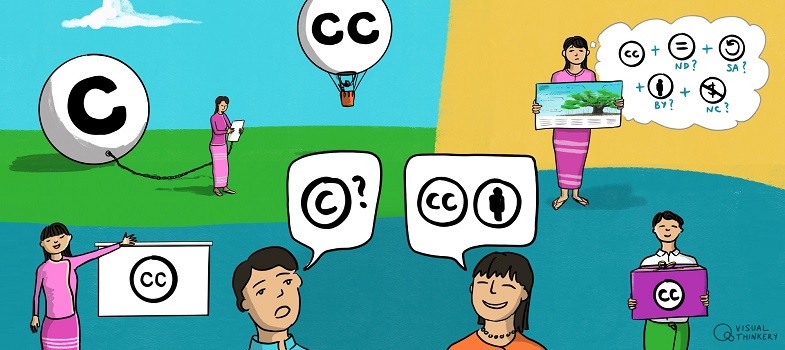Referencing
When you create a collection or remix OER, you must provide attribution for the individual works that you have used. This gives users of your OER the information they need to understand who created what and which licence terms apply to specific content. Your attributions should include the Title, Author, Source and Licence (TASL) for each of the OER you use.
As mentioned earlier, you can use an acknowledgements or sources section to organise this information. Using a disclaimer on the overall work also helps a user to understand what licence type has been applied to the overall work, but that there are exceptions. Let’s take a look at the different ways we can acknowledge OER use and when each is most appropriate.
Attributing a collection
Here are some examples of how you could attribute a collection. For example, you could have created a presentation or website that comprises your original content and openly licensed images. You could attribute each image on the relevant slide or where they are used online. Alternatively, depending on the resource, you could have the individual attributions listed on a separate slide of a presentation or on a separate page of a course.
In an appropriate place on the resource – such as the cover of a presentation or on the footer of a website – you could use one of the following statements, which would include a URL to the licence you are applying to your collection:
- [Name of resource] by [creator] is licensed [licence type], unless otherwise stated.
- Unless otherwise noted, [name of resource] by [creator] is licensed [licence type].
- This work was created by [creator] and is licensed under [licence type], unless otherwise stated.
In these three instances, you have either included all the TASL information required or you are providing an attribution within a context where it is clear what ‘this work’ is referring to. In addition, you have a disclaimer ‘unless otherwise stated’ or ‘unless otherwise noted’, which makes it clear to the user that there are exceptions and that resources with different license terms have been included.
If you don’t acknowledge individual pieces of OER as you use them (such as including an attribution next to a picture you use), you can list these in an acknowledgements or sources list. For example:

The example above shows the image and asset credits page for a course called Open Research 2014. The overall course is openly licensed (CC BY-SA 4.0). The course has a disclaimer similar to those listed above, acknowledging that it contains other OER.
The overall course licence applies to the original content created by the course authors (OER Hub). Openly licensed images used for the course are attributed separately.
Attributing a remix
When attributing a remix, you need to still ensure that you acknowledge every piece of OER that you have used, even though those OER may have been blended together to become indistinguishable from each other. For example, this course contains both remixed material and resources (such as images) that remain discrete. If you look at this course’s copyright and acknowledgements pages, you will see information on all the OER included in the course and a statement that acknowledges the course is a remix. When attributing a remix you have created you could use a similar statement. As you can see in the example below, this statement includes the disclaimer ‘unless otherwise stated’ to cover the inclusion of individual OER that are also used within the course.
‘[Name of new work]’ is an adaptation of [Name of work(s) you have remixed including URL to original resource(s)] published as of [date] (the ‘Original Work’), licensed by [name of creator(s) whose work you have adapted] under a [CC licence used on work(s) you have adapted and URL to these]. This adaptation is made and published by [your name] (the ‘Adapter’) under a [CC licence you have applied to your adapted work], unless otherwise stated.
The Adapter modified the Original Work in the following respects: [list of adaptations] (‘the Adapter Work’)
Collections
